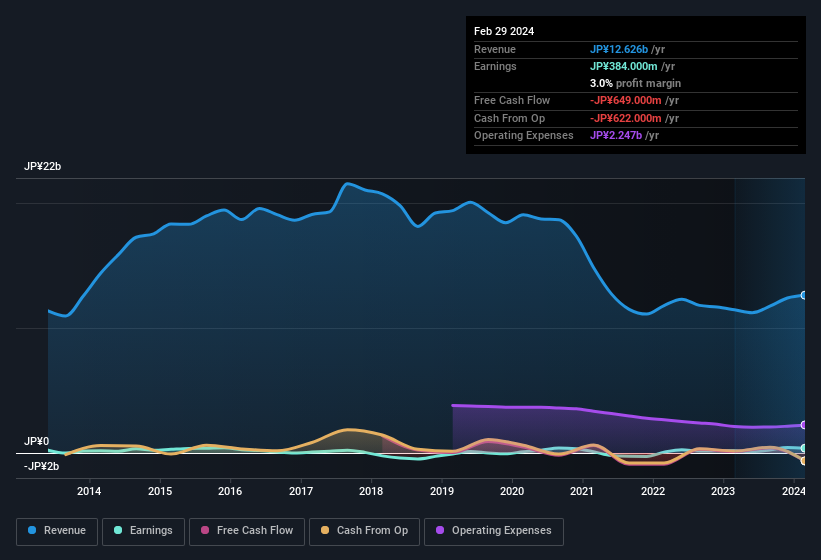- Japan
- /
- Commercial Services
- /
- TSE:1418
Interlife Holdings' (TSE:1418) Earnings Aren't As Good As They Appear

Interlife Holdings Co., Ltd.'s (TSE:1418) stock rose after it released a robust earnings report. However, we think that shareholders should be aware of some other factors beyond the profit numbers.
See our latest analysis for Interlife Holdings

A Closer Look At Interlife Holdings' Earnings
Many investors haven't heard of the accrual ratio from cashflow, but it is actually a useful measure of how well a company's profit is backed up by free cash flow (FCF) during a given period. To get the accrual ratio we first subtract FCF from profit for a period, and then divide that number by the average operating assets for the period. The ratio shows us how much a company's profit exceeds its FCF.
As a result, a negative accrual ratio is a positive for the company, and a positive accrual ratio is a negative. That is not intended to imply we should worry about a positive accrual ratio, but it's worth noting where the accrual ratio is rather high. Notably, there is some academic evidence that suggests that a high accrual ratio is a bad sign for near-term profits, generally speaking.
For the year to February 2024, Interlife Holdings had an accrual ratio of 0.30. Therefore, we know that it's free cashflow was significantly lower than its statutory profit, raising questions about how useful that profit figure really is. Even though it reported a profit of JP¥384.0m, a look at free cash flow indicates it actually burnt through JP¥649m in the last year. It's worth noting that Interlife Holdings generated positive FCF of JP¥119m a year ago, so at least they've done it in the past. However, that's not all there is to consider. We can see that unusual items have impacted its statutory profit, and therefore the accrual ratio.
Note: we always recommend investors check balance sheet strength. Click here to be taken to our balance sheet analysis of Interlife Holdings.
The Impact Of Unusual Items On Profit
The fact that the company had unusual items boosting profit by JP¥236m, in the last year, probably goes some way to explain why its accrual ratio was so weak. We can't deny that higher profits generally leave us optimistic, but we'd prefer it if the profit were to be sustainable. When we analysed the vast majority of listed companies worldwide, we found that significant unusual items are often not repeated. Which is hardly surprising, given the name. Interlife Holdings had a rather significant contribution from unusual items relative to its profit to February 2024. All else being equal, this would likely have the effect of making the statutory profit a poor guide to underlying earnings power.
Our Take On Interlife Holdings' Profit Performance
Summing up, Interlife Holdings received a nice boost to profit from unusual items, but could not match its paper profit with free cash flow. Considering all this we'd argue Interlife Holdings' profits probably give an overly generous impression of its sustainable level of profitability. So while earnings quality is important, it's equally important to consider the risks facing Interlife Holdings at this point in time. When we did our research, we found 3 warning signs for Interlife Holdings (1 is concerning!) that we believe deserve your full attention.
In this article we've looked at a number of factors that can impair the utility of profit numbers, and we've come away cautious. But there is always more to discover if you are capable of focussing your mind on minutiae. Some people consider a high return on equity to be a good sign of a quality business. While it might take a little research on your behalf, you may find this free collection of companies boasting high return on equity, or this list of stocks that insiders are buying to be useful.
New: AI Stock Screener & Alerts
Our new AI Stock Screener scans the market every day to uncover opportunities.
• Dividend Powerhouses (3%+ Yield)
• Undervalued Small Caps with Insider Buying
• High growth Tech and AI Companies
Or build your own from over 50 metrics.
Have feedback on this article? Concerned about the content? Get in touch with us directly. Alternatively, email editorial-team (at) simplywallst.com.
This article by Simply Wall St is general in nature. We provide commentary based on historical data and analyst forecasts only using an unbiased methodology and our articles are not intended to be financial advice. It does not constitute a recommendation to buy or sell any stock, and does not take account of your objectives, or your financial situation. We aim to bring you long-term focused analysis driven by fundamental data. Note that our analysis may not factor in the latest price-sensitive company announcements or qualitative material. Simply Wall St has no position in any stocks mentioned.
About TSE:1418
Interlife Holdings
Provides designs, constructs, manages, and maintains commercial facilities and public facilities in Japan.
Solid track record with excellent balance sheet and pays a dividend.
Market Insights
Community Narratives




